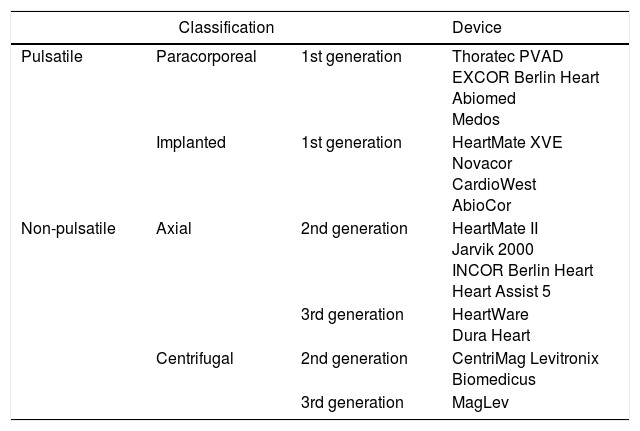Heart failure (HF) is a syndromic condition with a high incidence in current medicine. When the symptoms of HF progress, and become refractory, cardiac transplant is the best therapeutic option. However, due to the shortage of donors and the long waiting lists, many of those patients are candidates for implantation of ventricular assist devices as a bridge to the cardiac transplant, or when this is not an option, as a definitive therapy. A series of four clinical cases of patients with ventricular assist devices that required surgical intervention, is presented. Three of them were assisted with long-term care: two EXCOR (pulsatile and para-corporeal) and one HEARTWARE (non-pulsatile and intra-corporeal), and the last one with short-term assistance; CentriMag biventricular Levitronix. There is no significant literature on the peri-operative implications of these patients when they undergo urgent or scheduled surgery. The experience in our centre leads us to raise the need to determine a series of aspects: operation of each device, emphasising the correct placement of the cannulas during the surgery; the proper management of any medication, emphasising the importance of anticoagulant and anti-platelet therapies; the Pathophysiological changes at cardiopulmonary level due to the implantation of these devices; and the importance of the administration of a correct antibiotic therapy. Given the complexity of these cases, the limited experience in this field, and the few cases that exist in these situations, it is recommended to create protocols to ensure their proper management.
La insuficiencia cardiaca constituye un cuadro sindrómico de elevada incidencia en la medicina actual. Cuando los síntomas de la insuficiencia cardiaca progresan y se convierten en refractarios, la indicación de trasplante cardiaco es la mejor opción terapéutica. Sin embargo, debido a la escasez de donantes y a las largas listas de espera, muchos de estos pacientes necesitan la implantación de dispositivos de asistencia ventricular como puente a este trasplante, o en algunos casos, cuando el trasplante no es una opción, como terapia definitiva. En este artículo se presenta una serie de 4 casos clínicos en pacientes portadores de dispositivos de asistencia ventricular que precisaron intervención quirúrgica. Tres de ellos estaban asistidos con asistencias de larga duración: 2 EXCOR (pulsátiles y paracorpórea) y un HEARTWARE (no pulsátil e intracorpórea) y el último con una asistencia de corta duración; CentriMag Levitronix biventricular. No existe bibliografía significativa sobre las implicaciones perioperatorias de estos pacientes cuando son sometidos a cirugía urgente o programada. La experiencia en nuestro centro nos lleva a plantear la necesidad de conocer una serie de aspectos: funcionamiento de cada dispositivo, recalcando la correcta colocación de las cánulas durante la cirugía; el manejo apropiado de la medicación, recalcando la importancia de las terapias anticoagulantes y antiagregantes; los cambios fisiopatológicos a nivel cardiopulmonar debidos a la implantación de estos dispositivos; y la importancia de la administración de una correcta antibioterapia. Ante la complejidad que presentan estos casos, la escasa experiencia en este campo y los pocos casos que existen de estas situaciones se recomienda la creación de protocolos para garantizar un manejo correcto de estos.











